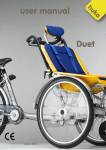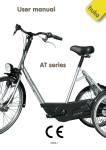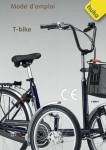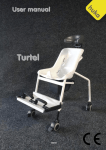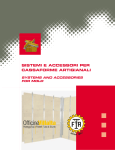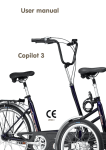Download user manual Duet
Transcript
user manual Duet version 2012.1 Introduction page 1 – 2 Product description page. 3 – 5 Adjust and preparations page. 6 – 12 Usage page 13 – 15 Maintenance page 16 -17 Index 1. Introduction 1 2. Product description 2.1 Purpose of use 2.2 Safety and driving behaviour 2.3 Prevention of theft 2.4 Drive 2.4.1 Duet with ‘Mountain’ drive 2.4.3 DUET with electrical drive 2.5 Technical 2.6 Dimension and Weight 2.7 Accessories 3 3 3 4 4 4 4 5 5 5 3. Adjust and preparations 3.1 Getting on and off 3.2 Brakes 3.3 Wheelchair and bike 3.4 Seat 3.5 The wheels 3.5.1 Pressure and valve 3.5.2 Spokes 3.5.3 Hubs 3.6 Crankshaft, crank and pedals 3.7 The chain 6 6 9 9 10 12 12 12 12 12 12 4. Usage 4.1 Riding the Duet 4.2 User environment 4.3 Familiar user errors 4.4 Brakes 4.4.2 Parking brake 4.5 The lighting 4.6 Safety lock 4.7 Lifting 4.8 Safety 13 13 14 14 14 14 14 15 15 15 5. Maintenance 5.1 Cleaning 5.2 Control 5.3 Tires 5.3.1 Tires pressure 5.4 Repair 5.4.1 Authorized dealers for repair 5.4.2 Spare parts 5.4.3 Self-execution of repairs 5.4.4 Disposal of the product 16 16 16 16 16 17 17 17 17 17 6. Duet Electro 18 Guarantee Huka BV gives two years of guarantee on the Duet. Your supplier will carry out this guarantee. The guarantee does not apply to damage or faults of the Duet caused by wrong or improper use. The evaluation of it is the privilege of Huka or a representative to be appointed by Huka. N.B. This guarantee does not apply to components susceptible to wear. Huka BV Huka is a Dutch company that manufactures appliances for the handicapped. If you have any queries about our products or their applications please contact your dealer. Huka BV Münsterstraat 13 7575 ED Oldenzaal The Netherlands tel: +31 (0)541 -572 472 fax: +31 (0)541 - 520 415 mail: [email protected] web: www.huka.nl Modifications Huka reserves the right to make modifications to the product described in this users manual without incurring liability. 1. INTRODUCTION Cycling should be a pleasant activity. That is clear. Every day millions of people mount their bicycles with pleasure. The bicycle is more than just of mean of transport. Cycling radiates freedom and adventure. By means of cycling we save our environment, we obtain somewhat more of the green feeling. But not everybody can make use of the ordinary bicycle. Huka has developed the Duet in order that everybody can enjoy all pleasant aspects of cycling. Aspects like ergonomics, sizes, quality and styling have all played an important role in the design. In general Your Huka Duet is a quality product. Every component of your Huka Duet has been tested and checked extensively. The finishing of the frame and the mounted components are of high quality. Therefore you are assured of an excellent product a careless cycle pleasure. When supplying your new Huka Duet, in principle all described components are adjusted well and/or are turned to you wishes. But no matter how modern, even a Huka Duet is not completely free of maintenance. There are some things that require attention from time to time. This small manual provides instructions for maintenance that you possible can do yourself and provides information about activities of your (Huka) dealer. To do a little maintenance can be quite fun, because it contributes to a greater cycle pleasure. Please pay particular attention to texts printed bold and in italics. 1 5. 1. 2. 6. 3. 7. 4. 10. 8. 9. 12. 13. 11. 14. Survey 1. Seat with safety belt 2. Armrests (option) 3. Operating and parking brake 4. Additional parking brake 5. Headrest (option) 6. Gear-Shift 7. Propulsion unit (bike) 8. Wheelchair 9. Jockey wheels 10. Footrest with option raised footrest 11. Height adjustment for steering bar 12. Pushrims (option) 13. Spoke shield (option) 14. Double Stand Please take notice of the attached manuals for the gear system, braking system, optional motor units and accessories! 2 2. PRODUCT DESCRIPTION 2.1 Purpose of use • The DUET is a carefully engineered combination of an individually adapted wheelchair and a bike with multiple gears. • The maximum load for the detachable wheelchair is 120 kg. • The road traffic act and all safety regulations have to be obeyed in all situations. • Every operation not described in this manual is forbidden. • The DUET may not be used by the wheelchair user or the bike user alone when both parts are connected. • Structural changes may not be detrimental to traffic safety. 2.2 Safety and driving behaviour Before you take delivery of your new ready-to-drive Duet your dealer will have checked all components himself and, if necessary, will have adjusted these in order that you can cycle. If it is the first time that you are sitting on a tricycle this will be somewhat uneasy. No matter how sporty your Duet is, never get tempted into too much enthusiastic behaviour on the roadway or riding on and off pavements. Your Duet can sustain visible or invisible damage, which involves additional risks. In order to use your Duet safely we advise you to (let) replace worn components like inner tubes, outer tubes, and brake block immediately. These components are obtained from every cycle shop or from your dealer. 1. The DUET biker must be at least 16 years old. 2. The DUET has to be checked for roadworthy condition before use. 3. The road traffic act and all traffic laws are to be obeyed on all journeys on public roads. Every road user must act in such a way that no other person can be jeopardized, damaged or hindered. 4. The wheelchair user has to be fastened with his safety belt according to his/her disability. 5. Always wear ANSI or BSI or GS approved safety helmets - both: the wheelchair user and the biker. 6. Caution on journeys on wet, slanting, uneven and slippery road surfaces or on tram rails. 7. For journeys in darkness a lighting system has to be mounted on THE DUET. At night switch on the lights. Be visible; wear brightly colored clothing. 8. In pedestrian areas THE DUET may go at walking pace only. 3 2.3 Prevention of theft A safety lock is mounted on most versions of the Duet. If you want additional measures against theft than an additional cable lock is convenient to anchor you tricycle rock-solid. These locks are available in many cycle shops. Always lock your tricycle, also when you leave it just for a short moment. 2.4 Drive 2.4.1 DUET with 'mountain-drive' With additional equipment like spoke cover, shoulder harness, stand and mountain drive gear box. The integrated planetary gear (can be switched on/off) with 1:2.5 reduction creates in combination with the 5-hub-gear a real 10 speed system. Mountain-drive gear Double stand Switch 2.4.2 DUET with electrical drive. Motor 24 V hub engine, 250 W battery 24 V, 18 Ah accumulator The engine is controlled by a grip shifter, but motor works only when the pedals are moved. 4 2.5 Technical • Seat, headrest (accessories) and footrest made from ABS composite, cushioning removable and cleanable (hand wash at 40°C) • Lap belt • Headrest removable (option) • Footrest removable, height and angle adjustable • Bike unit three times lacquered • Wheels 47-559 (26x1.75 inch) with integrated reflection stripes • SRAM Spectro S7-gear with back pedal brake • Front chain rim 38 tooth, rear 24 tooth with chain guard • On twin drum brake effecting parking brake (independent from air pressure) • Halogen lightning with dynamo • White front reflector • Signal bell • Air pump • Tool-kit with repair kit • bolt nut M4 and M5 2.6 Dimension and Weight Wheelchair length width height height weight Bike Unit length width height weight Combined length weight 80 up to 140 cm (with/without footrest) 65 cm/69 cm (with/without grip wheels) 107 cm (with headrest) 78 cm for transportation (picture L) 27 kg 131 cm 36 cm 85 cm (with saddle) 12,5 kg 265 cm 39,5 kg 2.7 Accessories There is an extensive accessory program available that includes push rims, armrests, rain covers, a cycle computer, a mountain-drive, a rear wheel motor and a carrier for car transport. 5 3. ADJUST AND PREPARATIONS First the wheelchair has to be adapted to the requirements of its user. 3.1 Getting on and off A Lower the wheelchair Clip in parking brake loop ( open, brake position), open coupling (see point O) and lower wheelchair on jockey wheels. B Tilt forward the footrest Getting on and off the wheelchair can be eased by swinging the footrest sidewards. Pull split pin (1), swing away footrest. Plug in split pin to close footrest again. C Footrest height Adjustment The height of the footrest (2) can be adjusted on the foot rest holder or by moving the holdfast (3). D Footrest angle adjustment (no picture) 2 holdfasts are mounted by bolts underneath the footrest. Loosen the bolts, adjust the angle and tighten the bolts. E Move footrest (no picture) Loosen all bolts on the footrest and take them off. Take off footrest and mount it in the desired position. Tighten bolts. F 1 F Headrest adjustment Loosen the bolts (1), adjust angle and height and tighten bolts. 6 G Headrest position Loosen the bolts, move headrest forward or backward, tighten bolts. The headrest can also be used as neck rest, depending on body height and kind of handicap. G H Belt The wheelchair user has to be fastened according to his/her handicap. Foot and ankle straps Thigh harness Lap belt Shoulder harness Velcro straps Harness clip 4 3 5 6 I Assembling of seat Position the seat on the tube-frame as it fits on the two bars (1) and (2) with its guides underneath. Close the fastening clamp on the bottom-side. Check correct fixing of the seat. Quick release to remove seat (Option) Open the fastening clamp and remove seat. 7 1 I 2 J Seat angle Pull back snap (1) and turn by 90° to lock it. Loosen the second snap and fix it in the desired position (2). Fix the first snap after another 90° turn. You should hear the snap-in an it should rest against the hull. After loosen both snap-springs you can move the support forward for easy storage and transport. J 2 1 Wheelchair Centre of Gravity The wheelchair's center of gravity should be adjusted such that the rear end of the connected bicycle does not tip up if the passenger (wheelchair rider) leans forward, when the bicycle rider is not on board. This adjustment should be performed by an expert. K Adjustment Remove seat, loosen 2 mudguard supports, loosen 4 holdfasts and move tube frame (use rubber hammer if necessary). Tighten bolts and adjust both mudguards. L Height adjustment for steering bar Open holdfasts(1) on both sides, adjust height and tighten bolts. In the same way the steering bar can be fixed for transport in the low position height. Tools (2) on both sides. 2 L Caution! If the holdfasts (1) are opened too far, be sure that the security snap and all fixations are in place firmly, especially the holes fit in the fixation points of the lower tube. 8 1 3.2 Brakes M Operating Brake To brake pull lever (1) upward. M Parking Brake To brake pull lever (1) upward an push parking brake loop forward until leaver is fixed To open parking brake pull parking brake backwards N Brakes fine adjustment The brakes are adjusted by the manufacturer. A fine adjustment can be done if necessary. Adjust operating brakes equally on both sides. Take care, that while turning the wheels without operating the brake there is just no resistance. Make several test tries, ensure that there is equal brake effect on both sides! The full adjustment of the brakes should be done by an expert. WARNING: Improper operation of brakes may cause serious personal injury! N 3.3 Wheelchair and bike The wheelchair rider may stay in the wheelchair. The wheelchair can be used separately. Pull parking brake ! O O Connect wheelchair Locate the bike unit (1) into the fork (2) at the wheelchair, tip wheelchair carefully until the coupling is connected. Clip in and close shackle (3). 3 5 4 2 Disconnect wheelchair Open shackle, lower wheelchair carefully and hang off bike unit. The shackle should be adjusted in a way that it can be opened and closed by slight pressure. The force necessary to open or close the shackle can be adjusted by the nuts (5). 9 P P Saddle Adjustment The bikers seat may be adjusted up or down, forwards and backward and tilted. Q Gears (1) For operation and maintenance instructions refer to separate manual. 3.4 Seat Q 1 Inside spoke cover Without seat This version allows mounting a customized orthopedic seat. It is mainly compatible to the version with seat. Instead of the seat with head-rest inside spoke covers are mounted. Seat suspension The seat is suspended by two seesaws (1) on telescopic forks (2). The elasticity can be adjusted continuously according to the weight of the wheelchair user. 10 This is done firstly by the assembly of the upper fixation of the telescopic fork. The hole position is depending on the weight of the wheelchair user and should be chosen according to the following scheme: 1 a Passenger weight 45 – 65 Kg 60 – 85 Kg 80 – 100 Kg 95 – 110 Kg 105 – 120 Kg Hole position => a => b => c => d => e 1 If the passenger weight is known this feature is already adjusted at the works. 2 4 The second step is the fine tuning of the spring tension (3) by turning the set screw (4). Take care that both sides have about the same tension. 11 3 b c d e 3.5 The wheels The wheels are the most important components of the cycle, which is responsible for a light ride and a high cycle comfort. Many matters are important thereby, like well-inflated tires tightly tensioned spokes and a light running with absence of play. 3.5.1 Pressure and valve The correct tyre pressure is obtained for most tires when you can still push the tyre in a little bit. When your tires are too soft they will wear down faster. You will ride much more comfortable on quite hard tires and your tricycle listens better to the brake and movements of the handlebars. 3.5.2 Spokes The spokes take care of the stability of the wheel and thus of the tricycle. Therefore a correct pressure is important. Because new spokes always have to stabilise to some extent, the wheels of your tricycle have to be checked after a couple of weeks. Then your Huka-dealer adjusts the spokes tot the correct tension. In case it happens that a spoke breaks or is getting loose then your Huka-dealer will of course put this right. 3.5.3 Hubs The hubs of the wheels should be adjusted accurately. Actually there should not be any noticeable play. If you notice an excessive play or the wheel is running heavily then ask your Huka-dealer to put this right. 3.6 Crankshaft, crank and pedals Most crankshaft bearings mounted by Huka are completely free of maintenance and cannot be re-adjusted. If it does happen that play develops in the bearing then it is necessary to contact your Huka- dealer immediately. If play develops between the crank and the crankshafts then you can take off the dust cap and retighten the underlying bolt with a socket spanner. Most pedals are also free of maintenance. If the play is too large you can consult your Huka-dealer. When you are mounting the pedals yourself watch for the indications L (left) and R (right on the pedal axes. The left pedal is screwed in anti-clockwise, the right pedal clockwise. You can use an open-end spanner or a special (narrow) pedal spanner. Specially adapted pedals can also be provided as an option. See paragraph 2.5 Accessories for this purpose. 3.7 The chain When the chain pressure is correct your Duet pedals lightly and you will not hear the chain. When your tricycle is delivered the chain will be well adjusted by your Huka-dealer. If you notice that one or the other chain is too slack have it re-adjusted by your Huka- dealer. This is very specified work that can be best left to your dealer. A plastic chain cover protects both the chain and the drive system. 12 4. USAGE 4.1 Riding the Duet • Check your DUET prior to riding on its safe and roadworthy condition. • As a three wheeled cycle the DUET has different performance characteristics than a regular two wheeler. Inexperienced riders should practice slowly first. • On a bicycle, you steer largely by leaning into corners. You cannot lean a three wheeler this way. The cyclist may improve the balance of the DUET on curves by leaning into the inner curve. You will notice that the DUET automatically leans the bicycle part into the curve. • The DUET has a wide turning circle so beware. Turning in a narrow situation can be eased if the cyclist gets off lifts the bike part a little and turns the whole machine on the spot. It is advised to ride the Duet with a passenger. The DUET is balanced for loaded operation, and actually it is less stable to ride without a passenger. . • Ride responsibly. • Safety before speed. • Always wear an approved safety helmet – both riders! • Caution on journeys on wet, slanting, uneven and slippery road surfaces or on tram rails. • It is not a racing machine. Moderately fast travel is possible where conditions are good - but slow down whenever there is danger or poorer road conditions. • Parking the DUET: - Push parking - Brake fully. • Protect your DUET by locking it up when you leave it, at home or away. • Do not neglect your legal responsibility towards the disabled. Warning! • Forbidden: the transport of objects of all kinds in the wheelchair. • Forbidden: the transport of more than one person in the wheelchair. • Forbidden: The DUET may not be towed or pushed by other vehicles. 13 4.2 User environment The Huka Duet is suitable for use on roads with firm underground. The Duet can be used into all weather, but avoid when possible contact with salt water because of the influence of the metal parts. 4.3 Familiar user errors The following user errors are possible and should be avoided. These errors can cause personal injuries or damage to the product. Respect the following situations: Always provide for the correct pressure of the tires. Avoid persons near the tricycle, particularly with the wheels, dangerous situations can occur. Check regularly the good functioning of the brakes and make sure the function perfect. Check regularly the good functioning of the lights and make sure the function perfect. Respect the traffic rules and regulations seriously and take caution in traffic. 4.4 Brakes 4.4.1 Parking brake All tricycles are equipped with a parking brake. This brake takes care that the tricycle stays firmly at its position when mounting or dismounting the tricycle. 4.5 The lighting Your Duet is provided with a safe and reliable lighting. Always check that all lights are working when you turned your lights on. It is highly dangerous when you ride in the dark, in the twilight or in the mist without lights. Check the following points if (part of) your lighting does not function: Check that the electric wires are connected to both lights and the dynamo and there is no formation of rust. Follow the electric wires and check that the insulation layer of the wires is still intact everywhere (check that there is no short circuit because of naked wires), Check that the lights in their fittings are free of oxidation, that contact is made and that the filaments are not broken, Check that the dynamo is adjusted well and is running on the middle of the tyre. Check that the electric wires are not broken and / or are not jammed anywhere. 14 4.6 Safety lock If you want to lock your Duet you should first turn the key clockwise and hold it before you can push the handle downward. If the lock is bolted the key jumps back and can be taken away. 4.7 Lifting It is because of the weight, not possible to lift your Duet alone. Lifting with two persons is possible. Pay attention to lift the Duet only at firmest parts and not for example the accessories. 4.8 Safety 1. The Duet has to be checked for roadworthy condition before use. 2. The road traffic act and all traffic laws are to be obeyed on all trips on public roads. Every user must act in such a way that no other person can be jeopardized, damaged or hindered. 3. Please wear a helmet every time using the Duet. 4. Caution on journeys on wet, slanting, uneven and slippery road surfaces or on tram rails. 5. For journeys in darkness a lighting system has to be mounted on the Duet. At night switch on the lights. Be visible; wear brightly colored clothing. 6. Always ride with reasonable speed and adjust your speed when going through curves. 7. When parking the Duet, make sure that the parking brake is locked. 15 5. MAINTENANCE 5.1 Cleaning Clean the DUET with water and shampoo. Never use a high pressure cleaner! The metal parts, the plastic parts and the soft parts, like saddle, can be best cleaned with a soft, moisten cloth. Here you can use soap. Use never aggressive or scratching cleaning agents. The different mechanisms should regularly controlled on impurities such as grain of sand etc. and when necessary be clean-brushed. Upholstery parts can be removed at wet weather or for washing (wash by hand, 40°C). Cleaning regularly aids the preservation of your tricycle. Never use a high-pressure cleaner for cleaning your cycle. This is because the pressure of the water is so forceful that you will spray the grease from the bearings. 5.2 Control To be checked regularly. These items/parts are subject to wear and tear: Chain – to be cleaned and greased Sprocket, chain rings and gear parts – to be cleaned and greased Brake cables – to be adjusted Tires – Check air pressure; low pressure can lead to more wear Lighting – check function – if necessary exchange bulb Handlebar cover – exchange eventually A bicycle shop must check regularly the spoke tension - the first time after approx. 300 km. 5.3 Tires Tire size and maximum tire pressure are written on the tire wall. We recommend to use the maximum tire pressure written on the tire wall. Check the tire pressure at the fuel station. In case of emergency, use the inflator attached to the frame. The tires are available at a local bicycle dealer. In case of pressure loss, the inner tube of the front wheels can be changed without removing the whole wheel. The tire walls are fitted with reflector strips. 5.3.1 Tire pressure The wheels have car valves (vents). You can refill air at each gas station. An air pump is mounted on the bike unit. Big 47-559 (26x1,75 inch) Small 200x50 mm 3,5 bar 2,5 bar 16 5.4 Repair 5.4.1 Authorized dealers for repair The dealer, which sold or delivered you the Duet, is authorized by Huka BV to execute necessary repairs. If you desire dealer, you can contact us: Huka BV Tel: +31 (0)541 572 472 Fax: +31 (0)541 520 415 e-mail: [email protected] 5.4.2 Spare parts Tyres an d tubes are available at bicycle shops or dealers. Defect parts of the wheelchair may only be exchanged against original spare parts. Huka BV can supply these parts on request of your dealer. 5.4.3 Self-execution of repairs It is not allowed to execute repairs yourself. By doing so your warranty claim and the guarantee at the product will expire. Repairs must be accomplished at any time by an authorized dealer. 5.4.4 Disposal of the product At the end of the life span of the product, as well as the accessories and the packing, these can be disposed of as normal waste. You should separate the product to the disposal into the different materials and hand these over to a garbage waste disposal facility. Safety This product meets the requirements fo the European guideline 93/42/EWG on medical products In the interest of maximum safety the Duet was approved by the Rheinisch-Westfälischen TÜV, Germany. 17 6. DUET ELECTRO 1. After the rump has been attached the connectors must be connected in the correct way. 2. The connector of the regulation must be put in the contact of the battery pack (Fig. A). A. 3. The cable of the sensor must be put in the most left opening of the regulation, then the fuse ring must be turned to the right (Fig. B). B. 4. In third connection the connector of the gear grip or from the cabinet of the pedal assistance. Also of this one the fuse ring must be turned (Fig. C). C. 5. The engine cable is coupled to fourth connection. After putting in the plug slightly turn to the right until no further possible (less than a quart turn) (Fig. D) D. 6. After that turn the key in the „On – position. Now the duet is ready for use (Fig. E) E. Before charge the connector of the control-box must be pulled out of the battery-pack, therefore you have to push button “A”. Now the connector of the charger can be connected. After that connect the charger to the power net. After end of charge the connector of the charger can be disconnected. Now the connector of the control-box can be connected. If the back-part will be released of the front part all electric connections must be disconnected. When the batteries are not a lot in use, it is better to charge the batteries once in a month completely. Time to charge is about 6 till 8 hours. The battery-pack has it’s full capacity after charge it a few times. Please also read the manual of the charger before use! 18 Your local supplier: Huka BV P.O. box 194, 7570 AD Oldenzaal Tel.: +31 (0)541 572 472 . e-mail: [email protected] www.huka.nl
























